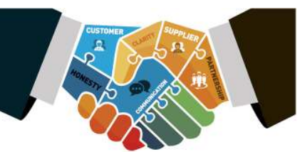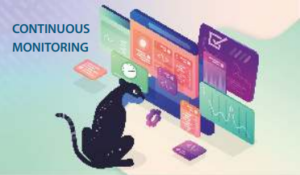
By Olena Chervonenko
Each organisation is responsible for ensuring their vendors provide consistent quality of services and materials which are fit for purpose throughout the product lifecycle from production development right through to commercial distribution. Vendor management is the process of working with vendors, controlling costs and increasing value whilst ensuring quality and managing mitigating risks.
A vendor in the pharmaceutical sector is an outside organization or provider who offers pharmaceutical businesses products, materials, services, or specialized knowledge. These suppliers are essential in supporting many facets of the pharmaceutical industry, from the production and distribution of pharmaceuticals to research and development. They contribute to the overall success of pharmaceutical operations and are an essential component of the pharmaceutical supply chain. Vendors might include a wide variety of organizations, each with a unique role and contribution to the industry.
Raw Material and Ingredient Suppliers:
Pharmaceutical manufacturers require a variety of raw materials and ingredients, which are provided by vendors in this area. Excipients, solvents, chemicals, Active Pharmaceutical Ingredients (APIs), and other raw ingredients required for the production and formulation of medicines can be among them.
Contract Manufacturing Organizations (CMOs):
Manufacturing and production services are offered by contract by Contract Manufacturing Organizations (CMOs). From formulation research and clinical trial material production through commercial-scale production activities, pharmaceutical companies may collaborate with CMOs at various stages of the drug-making process.
Testing and Quality Control Laboratories:
These companies are experts in carrying out thorough examinations and analyses of pharmaceutical items to guarantee their effectiveness, safety, and quality. They aid in verifying that goods adhere to set standards and regulatory criteria.
Pharmaceutical labelling and packaging suppliers:
Packaging vendors offer the resources and knowledge necessary to develop and create pharmaceutical labelling and packaging. Blister packs, vials, and bottles are examples of primary packaging materials, as are secondary packaging elements including cartons, labels, and inserts.
Technology and Equipment Suppliers:
Suppliers of cutting-edge machinery, equipment, and technological solutions for the production, research, and quality assurance of pharmaceuticals comprise this group of vendors. Suppliers can offer everything from pre-made, specialized production equipment and utilities to custom-made, off-the-shelf equipment for process automation and laboratory instruments.
Logistics and Distribution Partners:
These companies manage the distribution, storage, and transportation of pharmaceutical goods. They make sure that medications are delivered to their destinations securely, in accordance with legal requirements, and in accordance with Good Distribution Practises (GDP).
Pharmaceutical Consultants:
Pharmaceutical consultants offer a wide range of specialised services to assist businesses in navigating the complicated world of pharmaceutical legislation or with knowledge in particular fields.
Contract Research Organizations (CROs):
CROs provide pharmaceutical businesses with research and development services, including pre-clinical investigations, clinical trial management, data analysis, and regulatory submissions.
Specialized Service Providers:
Vendors providing specialized services like clinical trial services, data management, statistical analysis, pharmacovigilance, market research, medical writing, and more fall under this broad area.
Ensuring Quality Across the Vendor Spectrum: Accountability, Qualification, and Oversight
The responsibility of every organization is to maintain consistent quality in the services and materials provided by their vendors. This quality assurance process covers the entire lifecycle of the products, from the production stages to distribution. Effective vendor management is crucial for ensuring product quality, safety, and regulatory compliance. It involves working closely with vendors to control costs, add value, and uphold quality standards. At the same time, it requires diligently managing risks and optimizing the company’s operations and value chain. The EU-GMP guideline, specifically Chapter 7 on “outsourced activities,” designates the manufacturing authorization holder (MAH) as responsible for vendor qualification. When outsourcing activities, there must be a contract in place that clearly defines the duties of both the contract giver and the contract acceptor. It’s important to note that the contract giver retains ultimate accountability for ensuring proper control of outsourced activities. This includes clearly stating, in the quality management system, how the qualified person certifying each batch of product exercises their responsibility. Similarly, Annex 16, Section 1.5.4 of the EU-GMP guidelines outlines the pivotal role of the qualified person (QP) in certifying drug products for the market. The QP, representing the MAH, must ensure comprehensive documentation throughout the entire supply chain of the active substance and medicinal product, up to the point of certification.  Chapter 2 on “personnel” within the EU-GMP guidelines states that the heads of quality control, production, and quality assurance jointly bear the responsibility of endorsing and overseeing vendor activities. They play a critical role in approving and continuously monitoring vendors to uphold robust quality standards.
Chapter 2 on “personnel” within the EU-GMP guidelines states that the heads of quality control, production, and quality assurance jointly bear the responsibility of endorsing and overseeing vendor activities. They play a critical role in approving and continuously monitoring vendors to uphold robust quality standards.
Fostering Excellence: A Comprehensive Approach to Vendor Selection, Evaluation, and Management
The key stages of the product lifecycle are the ideal vendor selection, qualification, and continuing evaluation. These steps ensure that high-quality pharmaceutical goods are delivered in accordance with stringent regulatory criteria. Both industry expectations and regulatory agencies stress the necessity of a thorough vendor selection, exposing any potential gaps and evaluating vendor capability. They both emphasise a risk-based strategy and open communication.
A well-designed vendor management programme, a field in which PharmaLex excels in working with organisations to build a value-driven vendor management programme, provides a thorough description of vendor management. This programme includes vital elements that are critical to its effectiveness:
• Vendor Categorization: Depending on how they affect the quality, efficacy, and safety of the products, vendors must be classified specifically based on the QRM principles. High-risk vendors are subject to strict qualifications and requirements, assuring a complete procedure that complies with high standards. Through careful vendor regulatory research, risk assessment, and appropriate qualification processes, PharmaLex’s knowledge assists organizations in determining priority levels.
• Informed Vendor Selection: Determining user requirements for the materials in question forms the basis for informed vendor selection. Critical and non-critical vendors have different selection criteria, reflecting the importance of their contributions and the risks involved. A comprehensive vendor management program goes above and beyond and takes into account elements like vendor capabilities, capacity, and backup plans. A diverse team carefully evaluates the data in the case of crucial vendors, producing a small pool of possible possibilities.
• Comprehensive Evaluation: A well-structured programme requires a comprehensive assessment of possible vendors, based on a clear comprehension of their implications. Comparatively to non-essential suppliers, critical vendors go through a more thorough review procedure before being deemed to be accepted, ensuring that every aspect complies with high requirements. This procedure includes the entire vendor ecosystem because PharmaLex makes sure that every vendor complies with both organizational goals and legal standards.
• Risk-Driven Approach: A vital component of a successful vendor management program is the incorporation of a risk-driven approach. PharmaLex equips businesses to negotiate the complexity of vendor management by thoroughly analyzing risk variables. Businesses can therefore form alliances with vendors who are in tune not only with quality standards but also with the product’s inherent risks and the overall regulatory environment.
A crucial phase of the product lifecycle is the choice of the vendor and ongoing evaluation. A Vendor Management Programme that successfully navigates the complicated interplay of risk assessment, vendor selection, and continuing evaluation is developed thanks to the collaboration between PharmaLex and organizations, resulting in a harmonious union of organizational excellence and regulatory compliance.
The Importance of Risk Assessment
In order to ensure quality, regulatory bodies emphasize risk assessment.
• Extending Risk Assessment: The principles of Quality Risk Management extend beyond excipients to include APIs, service providers, and equipment. A risk-based strategy allows for a thorough assessment of potential dangers, allowing organisations to commit appropriate resources to risk mitigation. Collaborative risk assessment activities ensure a comprehensive view, identifying hazards connected with each vendor and their associated procedures.
• Vendor Qualification and Risk Assessment: Vendor qualification involves a comprehensive, proactive assessment of potential risks related to APIs, excipients, service providers, and equipment. The IPEC PQG GMP Guide and USP General Chapter 1078 are two established standards that can be used to define suitable risk assessment criteria. Numerous worldwide regulatory authorities have acknowledged the ICH Q9 “Quality Risk Management” [4] paper, which offers guidelines and illustrations of instruments for quality risk management that can be used to address various facets of pharmaceutical quality, including vendor management. Cross-functional teams ensure a comprehensive assessment by bringing a range of experiences to the table.
Harmonizing Excellence and Efficiency: The Dance of Quality and Cost in Selecting Alternative Vendors
Selecting and qualifying a vendor is a crucial chapter towards successful vendor management. It involves vigilance, collaboration, and continuous improvement, where quality and efficiency remain constant mantras. But this symphony doesn’t end here; it’s an ongoing process that demands continuous attention. Once a vendor is selected and qualified, the real orchestration begins, and it is a delicate dance that requires continuous attention. Pharmaceutical companies and their vendors must maintain their collaboration after qualification and even strengthen it further. The crossroad of selecting alternative vendors is critical as it requires striking a balance between maintaining quality and cost-effectiveness. The pursuit of excellence and cost management must be in harmony without either undermining the end product’s integrity. Maintaining quality in the pharmaceutical industry is of utmost importance as it embodies patient safety, regulatory compliance, and the company’s reputation. Hence, thorough due diligence before selecting an alternative vendor is essential to ensure that they adhere to good manufacturing practices (GMP) and have a robust quality management system. Although cost is a crucial factor in the equation, cost savings should never compromise quality. The transition to an alternative vendor requires a comprehensive risk assessment to evaluate their capabilities, track record, and alignment with the company’s values and objectives.  Cross-functional teams comprising experts from several fields must work collaboratively to choose the right vendor, and the idea of the total cost of ownership can be a useful tool in this decision-making process. Ultimately, the dance between quality and cost is a high stakes performance for the pharmaceutical industry, and it requires rigorous due diligence, collaboration, and a commitment to excellence to ensure uncompromised patient safety.
Cross-functional teams comprising experts from several fields must work collaboratively to choose the right vendor, and the idea of the total cost of ownership can be a useful tool in this decision-making process. Ultimately, the dance between quality and cost is a high stakes performance for the pharmaceutical industry, and it requires rigorous due diligence, collaboration, and a commitment to excellence to ensure uncompromised patient safety.
Elevating Quality Assurance: Tailored Evaluations and Rigorous Audits for Vendor Excellence
Upon identifying a shortlist of potential primary or alternative vendors based on their market reputation and cost, it is essential to evaluate the quality system of these vendors. This evaluation is crucial in determining whether the vendors have sufficient control over their operational processes. By conducting a comprehensive evaluation, we can gain a deeper understanding of the vendor’s performance and competency, which in turn highlights areas that may require improvement. The extent of this evaluation should align with the level of risk associated with the vendor. At Pharmalex, we are prepared to collaborate with organizations in developing customized vendor assessments that accurately reflect these risk profiles. Initiating this assessment early in the vendor selection process is of utmost importance and its integration into the overall risk assessment for the final product is vital. For vendors classified as non-critical or low-risk, the quality assessment may focus on specific sections of the vendor questionnaire or the submission of an ISO 9001 or equivalent certificate. On the other hand, high-risk vendors, particularly those providing critical materials or services, require on-site audits. These audits are tailored to the nature of the vendor’s services and their existing quality management system, adhering to standards such as GMP, GLP, GCP, or GDP. Importantly, when auditing finished products, we consider future potential markets to ensure alignment with diverse regulatory requirements within each jurisdiction. With our team of experienced auditors, Pharmalex is well-equipped to execute audits according to the relevant standards demanded by organizations, producing comprehensive and customized audit reports that provide all pertinent information. These reports facilitate the declaration of GMP compliance for API vendors. Lastly, it is crucial to perform a risk assessment to evaluate the potential impact of a vendor on the quality management system.
• Sustaining Risk Assessment in Vendor Management: As previously stated, including risk assessments into everyday operations and quality management systems is critical for long-term vendor management. Risk assessment profiles are reviewed on a regular basis and are updated in real time to ensure continual risk mitigation. The risk assessment process should be viewed as a supplement to regular audits, adding an extra degree of confidence.
Crucial to effective vendor management is the development of contractual Quality and Technical Agreements. Risk management should be integrated as a comprehensive control strategy within Quality and Technical Agreements between parties. These agreements function as a delineation of responsibilities, expectations, and quality processes, guaranteeing the consistent supply of products and services that meet established standards. In close adherence to section 7.14 of the EU-GMP guideline, Chapter 7 “Outsourced Activities”, PharmaLex collaborates with vendors to draft agreements that clearly outline roles and communication processes for outsourced activities. This proactive approach ensures that vendor comprehension of organizational expectations is precise, with exact details encompassing requirements such as Key Performance Indicators (KPIs). This, in turn, ensures an unwavering alignment of performance with expectations, continuous risk control and the seamless supply of quality products or services.
Continuous monitoring
After signing an agreement, it is crucial to continuously monitor and manage vendors. PharmaLex has established effective processes for evaluating vendor performance and addressing any issues that arise. This includes ongoing communication and collaboration to ensure vendors maintain the required standards and comply with regulations. Continuous monitoring, including assessments, audits, and performance reviews, is essential to identify and mitigate risks and find opportunities for improvement. By maintaining open communication and monitoring approved vendors, pharmaceutical companies can deliver high-quality products consistently while minimizing disruptions and ensuring patient safety. Effective vendor management is a vital part of the success and reputation of any pharmaceutical business.
In summary
PharmaLex’s expertise shines as a beacon in the ever-changing pharmaceutical market, where external trustful alliances are the cornerstone of growth. PharmaLex, a partner committed to going above and beyond compliance, welcomes you to embark on a journey of excellence. PharmaLex’s experienced professionals are ready to help you build up a vendor management programme, strengthen an existing vendor management procedure, or outsource the monitoring element within your organisation. With a proven track record of exceeding expectations,  we urge you to contact with us and learn more about the services we provide. Discover the assurance that comes with PharmaLex’s knowledge; a partner dedicated to your success. Harmonise with Self-assurance: Work with PharmaLex to leave an exceptional legacy in your pharmaceutical journey.
we urge you to contact with us and learn more about the services we provide. Discover the assurance that comes with PharmaLex’s knowledge; a partner dedicated to your success. Harmonise with Self-assurance: Work with PharmaLex to leave an exceptional legacy in your pharmaceutical journey.
References:
1. EudraLex Volume 4, Chapter 7 “Outsource Activities” – accessed via https://health.ec.europa.eu/system/files/2016-11/vol4-chap7_2012-06_en_0.pdf
2. EudraLex Volume 4, Annex 16 “Certification by a Qualified Person and Batch Release” – accessed via https://health.ec.europa.eu/system/files/2016-11/v4_an16_201510_en_0.pdf
3. EudraLex Volume 4, Chapter 2 “Personnel” – accessed via https://health.ec.europa.eu/system/files/2016-11/2014-03_chapter_2_0.pdf
4. ICH Q9 “Quality Risk management” – accessed via https://www.ema.europa.eu/en/documents/scientific-guideline/international-conference-harmonisation-technical-requirements-registration-pharmaceuticals-human-use_en-17.pdf
About The Author  Olena Chervonenko is an accomplished professional in pharmaceutical chemistry and quality management. With a Bachelor’s and Master’s degree in Pharmaceutical Chemistry from Odesa I.I. Mechnikov National University, she began her career as a Chemist-Analyst. Olena progressed to become a Leading Specialist, implementing GMP principles and integrating quality assurance into drug development. Later, as the Head of QA and CMC RA Departments, she successfully managed quality assurance, registration processes, pharmacovigilance and business development activities. She played a crucial role in establishing a Quality Management System (QMS) and GMP certifications. Currently, she serves as Associate Director Quality Management and Compliance at PharmaLex, where she continues to contribute her expertise in quality management and regulatory compliance.
Olena Chervonenko is an accomplished professional in pharmaceutical chemistry and quality management. With a Bachelor’s and Master’s degree in Pharmaceutical Chemistry from Odesa I.I. Mechnikov National University, she began her career as a Chemist-Analyst. Olena progressed to become a Leading Specialist, implementing GMP principles and integrating quality assurance into drug development. Later, as the Head of QA and CMC RA Departments, she successfully managed quality assurance, registration processes, pharmacovigilance and business development activities. She played a crucial role in establishing a Quality Management System (QMS) and GMP certifications. Currently, she serves as Associate Director Quality Management and Compliance at PharmaLex, where she continues to contribute her expertise in quality management and regulatory compliance.







